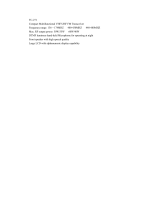
Contents
Introduction ..................................................................... 1
Specifications................................................................... 2
Accessories & Options ................................................... 4
Installation ....................................................................... 5
Preliminary Inspection ................................................. 5
Installation Tips ........................................................... 5
Safety Information ....................................................... 6
Installing the Microphone and Front Panel ................ 7
Power connections ....................................................... 8
Grounding .................................................................. 10
Mobile Station Grounding.................................... 10
Base Station Earth Grounding.............................. 11
Antenna Considerations ............................................ 12
Mobile Antenna Installations ............................... 12
Base Station Antenna Installations ...................... 13
RF Field Exposure ..................................................... 14
Electromagnetic Compatibility.................................. 15
Heat and Ventilation .................................................. 15
Linear Amplifier Interfacing...................................... 16
CW Key/Keyer Connections ..................................... 17
Receiver Accessories (Tape Recorder etc.) ............. 18
Adjusting the Front Feet ............................................ 18
Front Panel Control & Switches................................. 20
Multi Function Key Detail......................................... 24
Rear panel Connectors ................................................ 32
Operation ....................................................................... 34
Turning the Transceiver On and Off ......................... 34
Operating Band Selection.......................................... 34
Mode Selection .......................................................... 34
Adjusting the Audio Volume Level .......................... 35
Menu Quick Start ...................................................... 35
Adjusting the RF Gain and Squelch.......................... 36
Setting the Operating Frequency............................... 36
Changing the Dial Speed ........................................... 37
Stacked VFO System ................................................ 37
Receiver Accessories .................................................... 38
Locking Front Panel Controls ................................... 38
Clarifier ...................................................................... 39
IF Shift ....................................................................... 40
AGC ........................................................................... 41
Noise Blanker ............................................................ 41
IPO ............................................................................. 42
ATT (Front End Attenuator) ..................................... 42
DSP Bandpass Filter (DBP) ...................................... 43
DSP CW Peaking Filter (DBF) ................................. 44
DSP Noise Reduction (DNR) ................................... 44
DSP Notch Filter (DNF) ........................................... 45
AM/FM Tuning Dial Operation ................................ 45
Automatic Power-Off Feature ................................... 46
Transmitter Operation ................................................ 48
SSB/AM Transmission .............................................. 48
Basic Setup/Operation.......................................... 48
VOX Operation .................................................... 49
AF Speech Processor Operation .......................... 50
DSP Microphone Equalizer ................................. 51
CW Transmission ...................................................... 52
Operation using Straight Key/External Keying Device
.. 52
Using the Built-in Electronic Keyer..................... 54
FM Transmission ....................................................... 56
Basic Setup/Operation.......................................... 56
Repeater Operation .............................................. 57
Tone Search Scanning .......................................... 58
DCS Operation ..................................................... 59
DCS Search Scanning .......................................... 59
Split Tone Operation ............................................ 60
ARTS
TM
Operation ............................................... 61
CW Identifier Setup ........................................ 62
Digital Mode Operation (SSB-Based AFSK) .......... 63
RTTY (Radio Tele Type) Operation ................... 63
PSK31 Operation.................................................. 64
“User” Defined Digital Modes ............................ 64
Packet (1200/9600 bps FM) Operation .................... 65
WeatherFax Monitoring ............................................ 66
Time-Out Timer ......................................................... 67
Split Frequency Operation ........................................ 67
ATAS-100/-120 Operation ....................................... 68
Automatic Tuning ................................................. 68
Manual Tuning...................................................... 69
ATAS-100/-120 Operating Tips .......................... 70
FC-30 Automatic Antenna Tuner Operation ............ 71
Antenna Tuner Memory System .......................... 72
Memory Operation....................................................... 73
QMB (Quick Memory Bank) Channels ................... 73
Memory Operation on “Regular” Memory Channel
........ 74
Normal Memory Storage ..................................... 74
Split-Frequency Memory Storage ........................ 75
Memory Channel Recall ...................................... 76
Masking (“Hiding”) a Memory............................ 77
Memory Operation on “HOME” Channel Memories
....... 78
Labeling Memories after Programming Channel Data
..... 79
Spectrum Scope Monitor ............................................. 80
Smart Search
TM
............................................................ 81
Scanning Operation ...................................................... 82
Scanning Features ...................................................... 82
Scanning Operation ................................................... 82
Scan-Resume Choices .......................................... 83
Scan Skip Programming (Memory Mode only) .. 83
“Priority Channel” Scanning ..................................... 85
Programmable Memory Scan (PMS) Operation ...... 86
Dual Watch Operation............................................... 87
Miscellaneous Settings ................................................. 88
Operation on Alaska Emergency Frequency: 5167.5 kHz
... 88
CW Training Feature ................................................. 89
Programming the Panel Key Functions..................... 89
Beacon Feature .......................................................... 90
Beacon Text Storage ............................................ 90
Beacon Text Sending (On the Air) ...................... 91
Display Customization .............................................. 92
Display Lamp Mode ............................................. 92
Display Contrast ................................................... 92
Display Dimmer ................................................... 92
Display Color ....................................................... 93
Menu Operation ........................................................... 94
CAT (Computer Aided Transceiver) Operation . 113
Power-On Microprocessor Reset Procedures ........ 117
Cloning ......................................................................... 118
Installation Optional Accessories ............................. 119
Optional Digital Signal Processing Unit DSP-2
............ 119
Optional Filters:YF-122S, YF-122C, and YF-122CN
.... 120
Optional High Stability Reference Oscillator TCXO-9
.. 121
Appendix ...................................................................... 122
Setup of Memories
for Low Earth Orbit (LEO) FM Satellite Operation
....... 122
MH-59A8J Remote Microphone .............................. 125






















